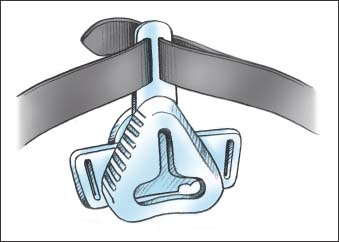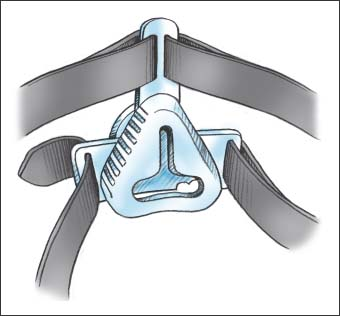Continuous Positive Airway Pressure Use
Continuous positive airway pressure (CPAP) provides constant low-flow pressure into the airways to help hold the airway open, mobilize secretions, treat atelectasis and, generally, ease the work of breathing. CPAP is also used to treat chronic obstructive sleep apnea because it prevents the palate and tongue from collapsing and obstructing the airway.1
Nonintubated patients receive CPAP through a high-flow generating system, which may eliminate the need for intubation. Many patients are started on CPAP in the health care facility and then continue therapy at home. Intubated patients may receive CPAP through a ventilator setting. Although CPAP has traditionally been administered through a face mask, other, more comfortable methods include the face pillow and nasal mask.
Because of the increase in thoracic pressure, CPAP is contraindicated in patients with increased intracranial pressure, hemodynamic instability, or recent facial, oral, or skull trauma.1
Equipment
Nasal mask, nasal pillows, or face mask (properly sized) ▪ permanent marker ▪ CPAP machine ▪ oxygen source ▪ oxygen delivery tubing ▪ washcloth ▪ water ▪ personal protective equipment ▪ Optional: oxygen source, pulse oximeter.
Preparation of Equipment
Set up the CPAP machine according to manufacturer’s instructions. Position the CPAP machine so that the tubing easily reaches the patient and plug in the machine. Don’t plug the CPAP machine into an outlet with another plug in it, and don’t use an extension cord to reach the outlet. Connect the CPAP machine to the oxygen source; then connect the oxygen delivery tubing to the air outlet valve on the CPAP unit, if ordered. Check the nasal mask, nasal pillow, or face mask to make sure the cushion isn’t hard or broken. If it is, replace it.
Implementation
Verify the doctor’s order.
Confirm the patient’s identity using at least two patient identifiers according to your facility’s policy.2
Explain the procedure to the patient and answer any questions to decrease anxiety and increase compliance.
Perform hand hygiene and use personal protective equipment, as appropriate, to prevent bacterial contamination.3,4,5
Wash the patient’s face with a washcloth and water to remove facial oils and help achieve a better fit.
Applying A Nasal Mask
Place the nasal mask so that the longer straps are located at the top of the mask (as shown below).

Make sure that the Velcro is facing away from you, and thread the four tabs through the slots on the sides and top of the mask (as shown below).

Pull the straps through the slots and fasten them using the Velcro.
Stay updated, free articles. Join our Telegram channel

Full access? Get Clinical Tree


Get Clinical Tree app for offline access
